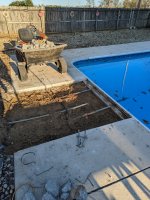My inground pool is 30 years old, which had a 30 year old diving board. The base of the board was extremely rusted when I moved into the house 2 winters ago, and I took the board out because I didn't trust it. This spring I am working on putting in a new diving board. I didn't like the idea of drilling holes and anchoring with concrete epoxy, so I decided to tear up a ~5'x5' slab and repour new concrete. My question is, should I use a foam expansion joint between the old slab and the new I'm pouring, or should I anchor it with rebar to the old?
Here's a pic of what I have torn out.

Here's a pic of what I have torn out.

Last edited:


